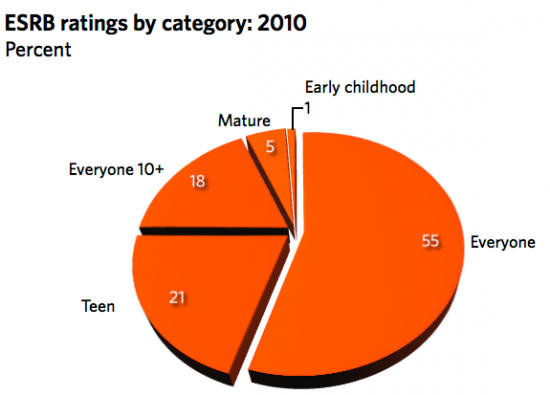 Five years ago this month, I penned a white paper on “Fact and Fiction in the Debate over Video Game Regulation” that I have been meaning to update ever since but just never seem to get around to it. One of the myths I aimed to debunk in the paper was the belief that most video games contain intense depictions of violence or sexuality. This argument drives many of the crusades to regulate video games. In my old study, I aggregated several years worth of data about video game ratings and showed that the exact opposite was the case: the majority of games sold each year were rating “E” for everyone or “E10+” (Everyone 10 and over) by the Entertainment Software Rating Board (ESRB).
Five years ago this month, I penned a white paper on “Fact and Fiction in the Debate over Video Game Regulation” that I have been meaning to update ever since but just never seem to get around to it. One of the myths I aimed to debunk in the paper was the belief that most video games contain intense depictions of violence or sexuality. This argument drives many of the crusades to regulate video games. In my old study, I aggregated several years worth of data about video game ratings and showed that the exact opposite was the case: the majority of games sold each year were rating “E” for everyone or “E10+” (Everyone 10 and over) by the Entertainment Software Rating Board (ESRB).
Thanks to this new article by Ars Technica‘s Ben Kuchera, we know that this trend continues. Kuchera reports that out of 1,638 games rated by the ESRB in 2010, only 5% were rated “M” for Mature. As a percentage of top sellers, the percentage of “M”-rated games is a bit higher, coming in at 29%. But that’s hardly surprising since there are always a few big “M”-rated titles that are the power-sellers among young adults each year. Still, most of the best sellers don’t contain extreme violence or sexuality.
The primary criticism of these findings is that (1) violence is subjective and, therefore, (2) you can’t trust the industry to accurately rate it’s own content. Plus, (3) kids still see a lot of violent content, anyway.
Violence certain is subjective, as I’ve discussed here numerous times before. And it’s also true that the ESRB was created by the video game industry as a self-regulatory body to rate the content of games. That doesn’t mean the ratings are deceptive, however. Indeed, polls have generally shown parental satisfaction with the system, and when you compare ESRB ratings to independent rating schemes (like Common Sense Media’s) you see largely the same sort of labels and age warnings being affixed to various titles. Sure, there are small differences at the margin, but they tend to be legitimately difficult cases (ex: how to rate a boxing game when the real-world equivalent is an actual sporting event that can be quite violent at times).
I’m never quite sure what to make of the third argument: that kids will still see a lot of violent games. If that’s true, is it the video game industry’s fault? Should no violent games be released because some kids might still find a way to see or play them? That’s an intolerable solution in a free society that treasures the First Amendment, of course. Moreover, it really comes back to parental choice and responsibility. When games cost $20 to $60 bucks a pop, it’s hard to even figure out how junior gets his hands on some of these games without Mom or Dad knowing. Moreover, even getting the game console into the house requires a significant outlay of cash, and even then, parents are prompted to set up parental controls when they get some of these devices. (All of them contain sophisticated controls but the initial configuration is slightly different on each).
In my opinion, the combination of the excellent ESRB ratings and the outstanding current generation console controls has resulted in one of the great user-empowerment success stories of modern times. Parents have been given valuable information about games to make decisions regarding what is appropriate for their families and then also given the tools to take action on that information by establishing console settings in line with their household values. Sounds like an ideal state of affairs to me. And, better yet, as the data above illustrate, parents don’t even have to worry about most games being inappropriate for kids!
Now, excuse me while I get back to playing “Plants vs. Zombies” on the XBox with my kids! What a great game that is. The whole family is loving it.

 The Technology Liberation Front is the tech policy blog dedicated to keeping politicians' hands off the 'net and everything else related to technology.
The Technology Liberation Front is the tech policy blog dedicated to keeping politicians' hands off the 'net and everything else related to technology.